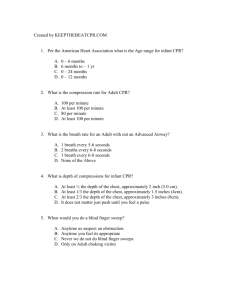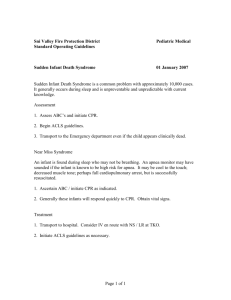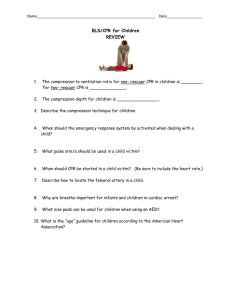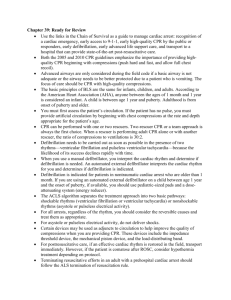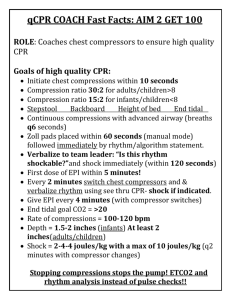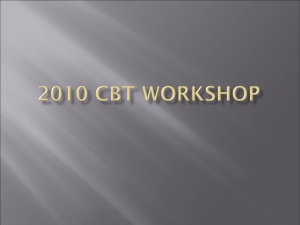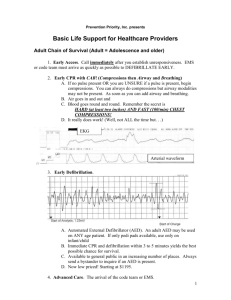PALS Study Guide - Florida Heart CPR
advertisement
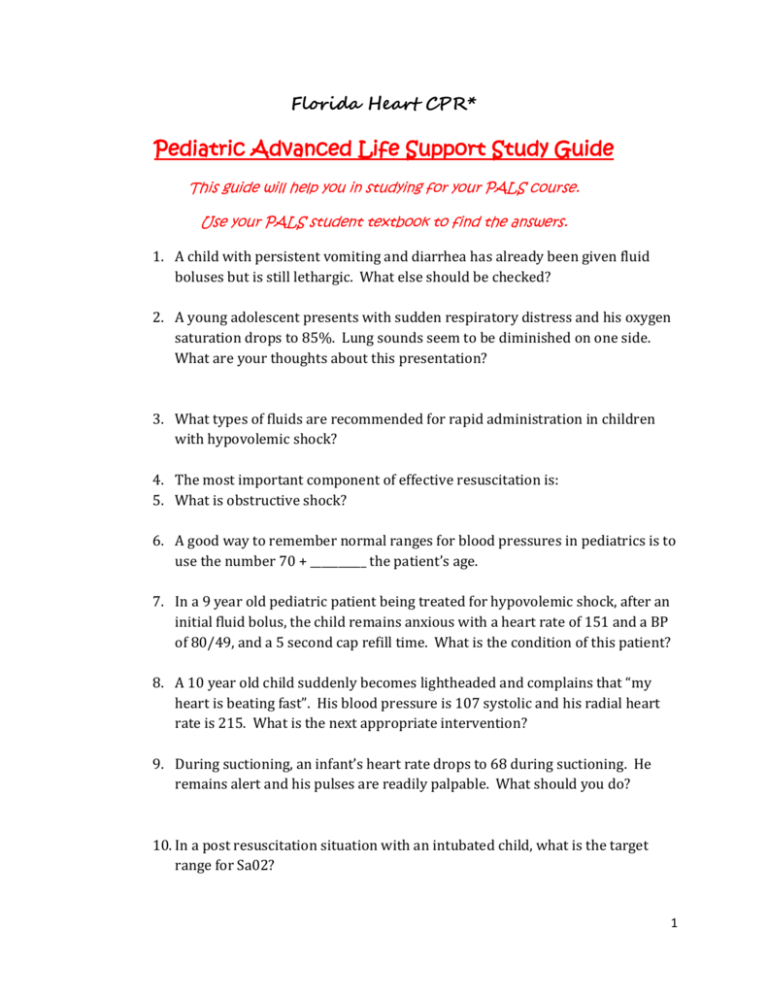
Florida Heart CPR* Pediatric Advanced Life Support Study Guide This guide will help you in studying for your PALS course. Use your PALS student textbook to find the answers. 1. A child with persistent vomiting and diarrhea has already been given fluid boluses but is still lethargic. What else should be checked? 2. A young adolescent presents with sudden respiratory distress and his oxygen saturation drops to 85%. Lung sounds seem to be diminished on one side. What are your thoughts about this presentation? 3. What types of fluids are recommended for rapid administration in children with hypovolemic shock? 4. The most important component of effective resuscitation is: 5. What is obstructive shock? 6. A good way to remember normal ranges for blood pressures in pediatrics is to use the number 70 + __________ the patient’s age. 7. In a 9 year old pediatric patient being treated for hypovolemic shock, after an initial fluid bolus, the child remains anxious with a heart rate of 151 and a BP of 80/49, and a 5 second cap refill time. What is the condition of this patient? 8. A 10 year old child suddenly becomes lightheaded and complains that “my heart is beating fast”. His blood pressure is 107 systolic and his radial heart rate is 215. What is the next appropriate intervention? 9. During suctioning, an infant’s heart rate drops to 68 during suctioning. He remains alert and his pulses are readily palpable. What should you do? 10. In a post resuscitation situation with an intubated child, what is the target range for Sa02? 1 11. After intubation, a child is moved from the stretcher to the CT table, and then back to the stretcher. Afterwards, the child’s heart rate suddenly drops to 62 and his oxygen saturation falls to 79%. What has happened and what should you do? 12. What is the best way to peform vagal maneuvers on a 4 month infant with SVT? 13. What is the depth of compressions on infants under a year old? What is the depth of compressions for a child up to puberty? 14. During CPR on a toddler, you recognize V-Fib on the monitor. What is the initial defibrillation energy dose for this child? 15. In a cardiac arrest due to drowning, the first drug to give to your patient is ______________. 16. A child with a known peanut allergy has recently been given a cookie by the neighbor and is in severe respiratory distress. What are your actions? 17. What would be a likely combination of treatments for a febrile, coughing child? 18. On an infant we check the pulse at the _______________ artery, and on a child we use the __________________ artery. 19. During the assessment for pulse in a possible cardiac arrest, we should check the pulse for no more than _______ seconds. 20. When considering synchronized cardioversion in a child or infant, we should use what energy level? ____________. 21. While doing CPR on a recent cardiac arrest in a child, you stop compressions to check the heart rhythm. The monitor shows a sinus rhythm with a rate of 71, but no corresponding pulse. What are your next actions? 2 22. Is it acceptable to use adult AED pads on an infant or child if no pediatric pads are available? 23. In an unwitnessed cardiac arrest of a child, we should do CPR for 2 minutes, but in a witnessed arrest, your first intervention should be: 24. When performing two person CPR on infants and children, what is your ratio of compressions to breaths? 25. In ANY unstable tachycardia your immediate intervention should be __________________________ _______________________ at a joule setting of : 26. Rescue breathing for a 6 year old child should be at a rate of ____ to ____ per minute. 27. What is the fluid of choice to administer to a hypovolemic child? What is the initial fluid bolus? 28. If you need immediate vascular access in a critically ill child you should provide what type of access? 29. Symptoms that include stridor or a barking cough would indicate ________________ _________________ __________________. What would be an appropriate initial treatment? 30. A rapid response team member suggests giving a dose of epi per the Broselow tape for a young patient in ventricular fibrillation after the first defibrillation. What other drug(s) could be prepared for future use in this code situation? 31. If a child is having difficulty breathing and lung sounds reveal crackles in the lower bases with an oxygen saturation of 95%, would it be appropriate to rely solely on pulse oximetry to determine the child’s condition? 32. A child that presents with lethargy and high fever with a low blood pressure is most likely in what type of shock? 33. What is a normal respiratory rate for an infant? 3 34. An infant with a low blood pressure (53/39) and a history of poor feeding would indicate what type of condition? 35. What condition causes a long expiratory phase and wheezing? 36. A child with a seizure is experiencing the post-ictal phase with irregular respirations. What is this situation called? 37. A child with acute pneumonia and respiratory distress might be said to have what condition? 38. Increased work of breathing is usually a sign of ___________________ ___________________. 39. An anxious 11 year old patient who was playing soccer in 92* heat presents with ventricular tachycardia on the monitor. How would you assess and treat this child? 40. The same 11 year old patient begins to lose consciousness. What are your next actions? 41. An 8 year old child has a narrow complex heart rate of 191. What would you call this heart rhythm? 42. During ventilation of an intubated patient, an alarm sounds on the ventilator and the 02 sat begins to drop. What might be your first action? 43. The patient evaluation process contains 3 components. What are they? 44. It has been a 14 minute down time for a cardiac arrest on a 13 year old child. The initial rhythm was PEA, and the patient received 2 doses of epinephrine before becoming asystolic. What actions should you consider? 45. Atropine is recommended for use in bradycardia in pediatrics in what situation? 4

